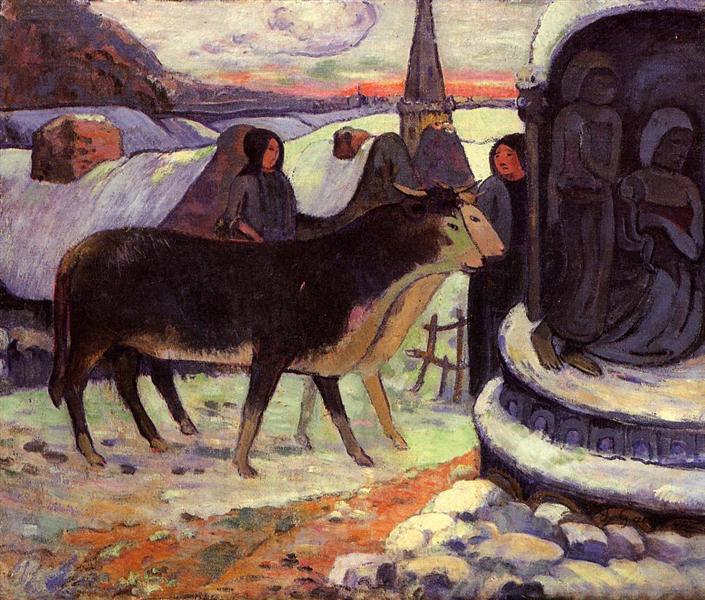Description
Post-Impressionist master Paul Gauguin's 1894 painting "Christmas Eve" is a work that reflects not only his technical mastery, but also his unique ability to weave the spiritual and the everyday into a vividly cultural setting. Looking at the work, we are presented with an evocative scene set during the Christmas holiday, where the religious and the festive combine in a representation rich in symbolism.
In the foreground, the central figure is likely a mother with her child, suggesting the act of maternal reverence and care. This representation of motherhood is recurrent in Gauguin’s work, who often explored themes of family life and childhood. The mother appears to be praying or contemplating, a gesture that hints at a deep spiritual connection, in keeping with the meaning of Christmas time. Nearby, other figures can be perceived, which, although not the main focus of the work, contribute to the sense of community and ritual that the scene evokes.
The colors of the painting are deeply expressive, as is characteristic of Gauguin’s work. The vibrant palette uses saturated shades of blue, green, and red, creating an immersive atmosphere that transforms the visual experience into an emotional one. The blue of the background, contrasted with warm lights, creates a sense of nocturnal light that is both comforting and reverent. This use of color not only highlights the central figure, but also evokes the serenity of the night, an essential aspect in the painting’s narrative.
The composition is carefully balanced, with lines and shapes flowing organically, but also purposefully. Gauguin uses an arrangement that draws the viewer's gaze from the main figure to the surrounding elements, suggesting a narrative in which each figure and color plays a role in the whole. The creation of spaces within the work invites a more intimate interpretation, where viewers are encouraged to reflect on their own experiences and beliefs.
From a historical perspective, “Christmas Night” not only stands as a masterpiece within Gauguin’s body of work, but is also a reflection of his interest in non-Western cultures. The influence of his time in Tahiti can be felt in the way he captures the simplicity of everyday life and its connection to the sacred. This inclination towards the exotic and spiritual becomes a common thread that can be seen in various works from his career, such as “Where Do We Come From? What Are We? Where Are We Going?” which also confront existential questions through a personal and modern lens.
In the end, “Christmas Eve” stands as a powerful example of how painting can function not only as an aesthetic medium, but also as a vehicle for deeper meaning. The work invites viewers to consider not only the act of celebrating, but also the sense of community, family, and spirituality—components that, in the end, are universal. Through Gauguin’s gaze, we are confronted with the essence of the festivities, not just on their surface, but in the soul that animates them.
KUADROS ©, a famous painting on your wall.
Hand-made oil painting reproductions, with the quality of professional artists and the distinctive seal of KUADROS ©.
Painting reproduction service with satisfaction guarantee. If you are not completely satisfied with the replica of your painting, we will refund 100% of your money.

